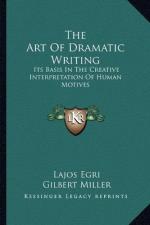
|
| Name: _________________________ | Period: ___________________ |
This test consists of 5 multiple choice questions, 5 short answer questions, and 10 short essay questions.
Multiple Choice Questions
1. The author believes the writer to be lost if he is spending his time worrying about _____.
(a) The climax.
(b) Developing secondary characters.
(c) The introduction.
(d) What others will think.
2. What playwright does the author assert produced badly written plays after World War II had just finished, and dealt with problems rather tame and different, compared to what people had just gone through with the war?
(a) Osias L. Schwarz.
(b) Erskine Caldwell.
(c) Robert E. Sherwood.
(d) Noel Coward.
3. Who suffers from inherited syphilis in the play "Ghosts"?
(a) Oswald.
(b) Jacob.
(c) Regina.
(d) Helene.
4. "Hymn to the Rising Sun" is cited in Book IV: General, Chapter 3: Dialogue to prove how _____ can be put forth competently without force or illogical, out-of-character dialogue?
(a) Rhetoric.
(b) Ideas.
(c) Messages.
(d) Opinion.
5. What is often referred to as the scene for which everyone is waiting, the scene which has been promised throughout and which cannot be eliminated?
(a) Signature.
(b) Epic.
(c) Obligatory.
(d) Climax.
Short Answer Questions
1. Who wrote the play "Tobacco Road"?
2. Who wrote the play "Tartuffe"?
3. The author writes that transition has the power to connect two emotions that are seemingly _____.
4. What philosopher surmised that "every story must have a beginning, middle, and an end"?
5. What happens at the end of "The Cherry Orchard"?
Short Essay Questions
1. Why might a writer have difficulty with entrances and exits in his play? What does the writer suggest?
2. How does the author approach the discussion of exposition in a dramatic work?
3. How is the point of attack defined? Where should it take place, according to the author?
4. How does Egri's student describe the importance of dialogue in Book IV: General, Chapter 3: Dialogue?
5. How does the author relate character to action and environment?
6. What is Egri's response to Aristotle's theory on story structure?
7. What example does the author present for the emergence of conflict in Book III: Conflict, Chapter 1: Origin of Action?
8. How does the author describe jumping conflict?
9. What kind of conflict does the author exemplify in the play "Idiot's Delight"?
10. What does Egri show by example with the play "Stevedore"?
|
This section contains 978 words (approx. 4 pages at 300 words per page) |

|




